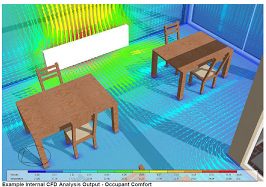Building Energy Management System
It describes a system which has been designed to reduce energy consumption in buildings up to 40%; with achievement of optimal trade-off between energy saving and Indoor Air Quality (IAQ) and in particular.
This will be done through smart monitoring and intelligent decision-making system of the Building Energy Management System (BEMS).

Implementation of the CFD simulation (Computational Fluid Dynamics) tool in the existing BEMS will be a key element to improve energy efficiency in buildings.
SEB-CFD, could be addressed as the most optimum method for controlling the energy consumption. SEB-CFD controls, manages and monitors building equipment such as lightening, HVAC, boiler, and fan systems.

It is obvious that in addition to creation of comfortable conditions and improving automation, the current costs of the building will decrease through energy consumption optimization.
Traditionally the BEMS systems are operated manually, based on set point tables that correspond to steady state operation. SEB-CFD aim to develop a control system based on a CFD numerical model of different operating parameters such as temperature, pressure, air velocity, pollution, etc that is used to automatically calculate zone set points that are intended to be implemented to the BEMS system.

SEB-CFD will be employed to optimize the air flow, indoor temperature (based on outdoor temperature) and pressure. That is a primary guide for better recommendation in decreasing of energy consumption.
Key Questions Addressed:
• What is the definition of a building energy management system (BEMS)?
• How have BEMSs evolved in the last 5 years?
• Who are the key players in this market?
• What are the major drivers for market growth?
• How large is the BEMS market and which segments will experience the fastest growth from 2015 to 2024?
• What are the technology, customer, and market dynamics shaping the future of BEMSs?
Who needs this report?
• Building energy management system (BEMS) providers
• Commercial building automation system (CBAS) vendors
• Lighting controls manufacturers
• Electric utilities
• Commercial real estate (CRE) providers
• Corporate energy and sustainability executives
• Government agencies
• Investor community
Building Management Systems are most commonly implemented in large projects with extensive mechanical, HVAC, electrical, and plumbing systems. Systems linked to a BMS typically represent 40% of a building’s energy usage; if lighting is included, this number approaches to 70%. BMS systems are a critical component to managing energy demand. Improperly configured BMS systems are believed to account for 20% of building energy usage, or approximately 8% of total energy usage in the United States.
In addition to controlling the building’s internal environment, BMS systems are sometimes linked to access control (turnstiles and access doors controlling who is allowed access and egress to the building) or other security systems such as closed-circuit television (CCTV) and motion detectors. Fire alarm systems and elevators are also sometimes linked to a BMS, for monitoring. In case a fire is detected then only the fire alarm panel could shut off dampers in the ventilation system to stop smoke spreading and send all the elevators to the ground floor and park them to prevent people from using them.
Auditing
The amount of energy consumption and indoor air quality in different parts of the building at different time (day or night/ months and season) and providing appropriate solutions.
The Energy audit of the building can be used to measure and record real energy consumption in building and consequently minimizing energy consumption.
Energy audit aims to:
a) Simulation of Heat and mass transfer in the building, including heat and cooling design, annual simulation, CFD (computational Fluid Dynamic), daylight and cost
• Reduction of energy lost in building
• How external environment effects on energy lost in the building
• Anticipating energy costs and expressing consumption pattern of heat transferring
b) Online monitoring of temperature, pressure, humidity, lighting, indoor air quality (such as CO2, CO, NO2 and smoke) by means of installing sensors.
Light
The goal is to reduce “light” energy consumption in buildings up to 40%, with best building lighting condition.
MAIN SPECIFICATIONS:
• Web based monitoring and control of building light
• Light adjustment
• Time adjustment
• Smart presence control
CFD Simulation
In the following the micro CFD simulation tool (again Design builder CFD) will be employed to provide a detail indoor air quality information as well as local weather information helping with design optimization of the measure energy consumption on different HVAC schedules, , and energy interval data.





